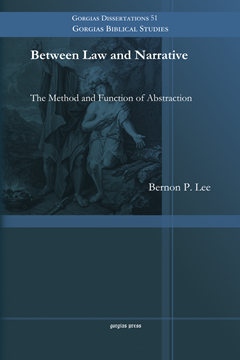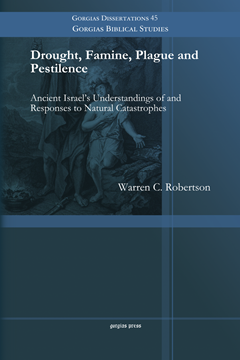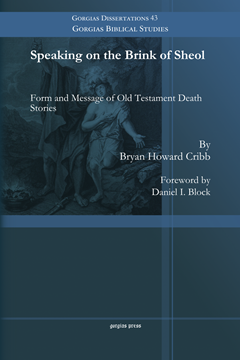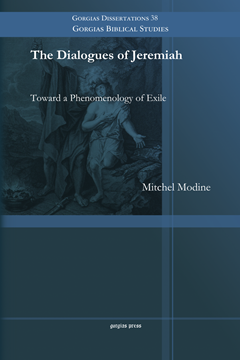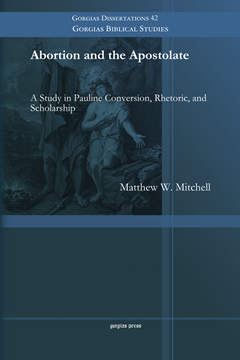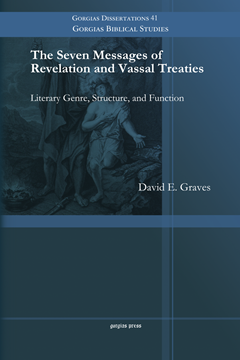Between Law and Narrative
The Method and Function of Abstraction
Series: Gorgias Biblical Studies 51
ISBN: 978-1-4632-0373-3
Aside from being the content of speeches by characters in narrative, how do passages of laws in the Pentateuch interact with the surrounding narratives? This book proposes that certain passages of law in Leviticus and Numbers offer direction for the interpretation of adjacent segments of narrative. This 'direction' may serve to emphasize select themes and concepts in narrative. Alternatively, it may misdirect readers, or suggest alternative options to more accessible interpretations for a stretch of narrative.
$108.00 (USD)
Drought, Famine, Plague and Pestilence
Ancient Israel’s Understandings of and Responses to Natural Catastrophes
Series: Gorgias Biblical Studies 45
ISBN: 978-1-4632-0374-0
This interdisciplinary study integrates textual analysis of the Hebrew Bible and comparable ancient Near Eastern material with social theory and archaeology in order to articulate the ancient Israelites' taken-for-granted understandings of natural disasters, their intellectual and theological challenges to those understandings, and their intellectual and theological reconstructions thereof.
$80.00 (USD) $48.00 (USD)
Speaking on the Brink of Sheol
Form and Message of Old Testament Death Stories
By Bryan Howard Cribb; Foreword by Daniel I. Block
Series: Gorgias Biblical Studies 43
ISBN: 978-1-4632-0375-7
Since its inception at the beginning of the twentieth century, form criticism has diminished in popularity and use in recent years. Bryan H. Cribb’s studies demonstrates that, if appropriately modified, form criticism still has much to add to Old Testament studies. Using a synchronic and inductive approach to the text, Cribb engages in a form critical study of nine “death stories” in the Old Testament. In so doing, he not only provides substantial support for the existence of this genre, but he also shows how remarkably fruitful such a study can be in revealing the messages of these accounts.
$118.00 (USD)
The Dialogues of Jeremiah
Toward a Phenomenology of Exile
Series: Gorgias Biblical Studies 38
ISBN: 978-1-4632-0376-4
An emerging consensus maintains that the exile was not as extensive as the Old Testament claims. However, that it held singular importance for the book of Jeremiah is beyond question. Modine argues that Jeremiah represents a range of options for understanding and responding to the events surrounding the destruction of Jerusalem and its temple. This volume reads the diverse contents of Jeremiah as a kind of dialogue between competing perceptions of the exile. The author argues that coherence is to be found precisely in the incoherent, as it reflects the communal trauma of exile.
$106.00 (USD)
Abortion and the Apostolate
A Study in Pauline Conversion, Rhetoric, and Scholarship
Series: Gorgias Biblical Studies 42
ISBN: 978-1-4632-0377-1
This book argues that it is the rejection of Paul’s claims to be an apostle in the same sense as the other apostles that ultimately underlies his “mission to the Gentiles.” This argument is advanced through a careful analysis of Paul’s references to his “conversion” in Galatians 1:15-17 and 1 Corinthians 15:8, paying particular attention to Paul’s evocative use of the language of abortion. The contextualization of this curious self-description in 1 Corinthians 15:8 draws upon a growing body of work concerning an area of ancient life that continues to fascinate and perplex moderns; the exposure of unwanted infants.
$93.00 (USD)
The Seven Messages of Revelation and Vassal Treaties
Literary Genre, Structure, and Function
Series: Gorgias Biblical Studies 41
ISBN: 978-1-4632-0378-8
This book argues that the genre of the seven messages in Revelation 2–3 is a hybrid prophetic oracle. This oracle is influenced by the Old Testament covenantal elements functioning as a set of lawsuit exhortations. Graves defends this by demonstrating the influence of the Ancient Near Eastern vassal treaty structure in the seven messages. Written in a readable format this work is both an excellent introduction to the book of Revelation as well as a fitting work for the apocalyptic specialist.
$145.00 (USD) $87.00 (USD)
